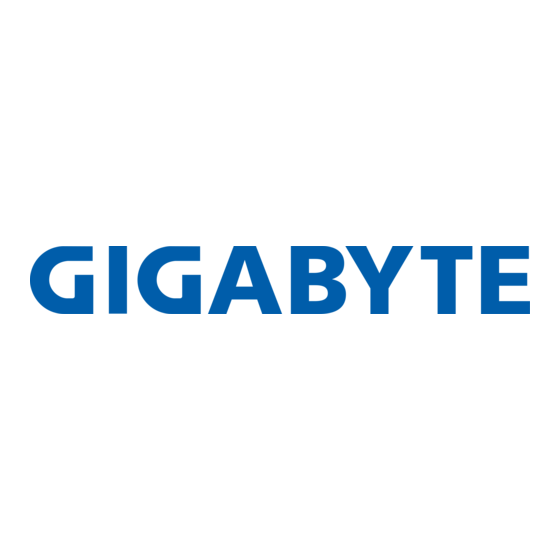
Summary of Contents for Gigabyte GN-WLMA101
- Page 1 GN-WLMA101 IEEE 802.11a/b/g Dual-band Wireless LAN Card User’s Manual http://www.gigabyte.com.tw Rev. 1.0 First Edition...
-
Page 2: Table Of Contents
CHAPTER 1. PRODUCT OVERVIEW 1-1. I ...1 NTRODUCTION 1-2. F ...1 EATURES 1-3. P HYSICAL IMENSIONS 1-4. LED I NDICATING 1-5. S YSTEM EQUIREMENTS 1-5-1. Supported Platform ...2 1-5-2. Supported Operation System...2 CHAPTER 2. INSTALLING THE WLAN CARD 2-1. I NSTALLING RIVER CHAPTER 3. -
Page 3: Chapter 1. Product Overview
Chapter 1. Product Overview 1-1. Introduction This 802.11a/b/g Wireless Local Area Network (WLAN) card is composed of the MAC, Baseband, and radio components, CARDBUS interface, and two built-in antennas. It operates in 2.4GHz and 5GHz frequency bands, providing fast (up to 108Mbps) and secure (support AES, 802.1x &... -
Page 4: Led Indicating Light
1-4. LED Indicating Light Power: The Power LED lights up when the WLAN card is powered on. Link The Link LED lights up when the WLAN card has an active connection. If the LED isn’t on, the card isn’t interfacing with the network. 1-5. -
Page 5: Chapter 2. Installing The Wlan Card
Chapter 2. Installing the WLAN Card 2-1. Installing The Driver & Utility (Applicable to any supported OS) Step 1: Please make sure that you don’t plug your card yet. Step 2: Insert our setup CD into your CDROM drive, the following window will pop up. Step 3: Click “Install Wireless LAN Driver”. - Page 6 Step 5: Click “Finish”. The wizard will install the driver. Step 6: Click “OK”. Step 7: Click “Yes”. Step 8: Click “Yes”, and then your installation is ok.
-
Page 7: Chapter 3. Using The Utility
Chapter 3. Using The Utility The Configuration & Monitor Utility is a powerful application that helps you to configure the card and monitor the statistics of the communication link. Unlike the standard method of configuring the card via the operating system utilities (e.g. Control Panel), this application permits the dynamic modification of the configuration parameters while the card is operating. - Page 8 Figure 3-3. Turn off the card’s radio Other items reports the following information: Association State: The field shows you if WLAN card is communicating with an access point or peer-to peer group. MAC Address: This card’s physical address. Channel [Freq]: The current channel and center frequency used by the WLAN card. Security: The current security setting.
-
Page 9: 02.11A/B Site Survey
3-2. 802.11a/b/g Site Survey The “802.11a/b/g Site Survey” tab shows you the list of reachable access points and/or peer-to-peer stations. In Fig 3.4, the card one four 802.11a and two 802.11b and one 802.11g wireless devices. Figure 3-4. Reachable access points and/or peer-to-peer stations Other items reports the following information: SSID: Wireless network name. -
Page 10: Statistics
3-3. Statistics The “Statistics” tab shows you the number of packets sent and received by the card. Figure 3-5. The statistic number of packets sent and received by the card 3-4. Configuration The “Configuration” Tab contains several fields where operating parameters of the driver can be viewed or changed. - Page 11 Figure 3-6. Configuration Ad Hoc channel: When the card’s network mode is set to Ad Hoc, you can select a channel from the AD Hoc channel drop-down menu for your Ad Hoc group to use. SSID: This is the wireless network name expressed as text string that all members within the same network share.
- Page 12 Figure 3-7. Advance configuration screen Transmit Power Level: Select 100%, 50%, 25%, 12.5%, or lowest transmit power. 3-4-3. Encryptions: This card provides three security options: No security, WEP encryption and 802.1x security architecture. 3-4-3-1. No security: Allows the communication between the WLAN card and access point without data encryption.
- Page 13 Figure 3-8. Configure WEP Key 3-4-3-3. Use Dynamic Security (Leap, 802.1X, etc.): 802.1X is an IEEE security standard for network security access control. It is used to control access to wired and wireless networks and dynamically provide keys for encryption. To use this function, an access point with its 802.1X function is required to act as an intermediary between WLAN card and the network’s RADIUS (Remote Authentication Dial-In User Service) server.
- Page 14 Figure 3-10. Wireless Network Connection Status 5. Click “Authentication” tab (see Figure 3-11). Configure your 802.1X settings. Figure 3-11. Authentication Screen 6. Click “Wireless Networks” tab (see Figure 3-12).
- Page 15 Figure 3-12. Wireless Networks Screen 7. Click “Configure” button, then the following window will pop up (see Figure 3-13). Figure 3-13. Wireless Networks Properties...
-
Page 16: Driver Info
8. Click “Data encryption (WEP enabled)” and “The key is provided for me automatically”. 9. Click “OK” twice to save these setting and exits the windows. 3-5. Driver The “Driver” tab shows you the information of the card’s driver. Figure 3-14. Driver’s information... -
Page 17: Chapter 4. Specifications
4-1. System Host Interface Operating Voltage 4-2. RF Performance 802.11A Frequency Band Modulation Technology Modulation Techniques Date Rates Typical Power Consumption Output Power Minimum Receive Sensitivity Antenna 802.11B Frequency Band Modulation Technology Modulation Techniques Date Rates Typical Power Consumption Output Power Minimum Receive Sensitivity Antenna 802.11G(BACKWARD COMPATIBLE TO 802.11B) - Page 18 Windows 98SE/Me/2000/XP AES; 802.1X client for Windows XP; 64/128/152 bit WEP 802.11e draft supported Supported Seamless roaming among 802.11a/b access Monitors the network situation. 120 x 54 x 13 mm 41 g Packaging specially used by Gigabyte. Power and Link points.



Need help?
Do you have a question about the GN-WLMA101 and is the answer not in the manual?
Questions and answers